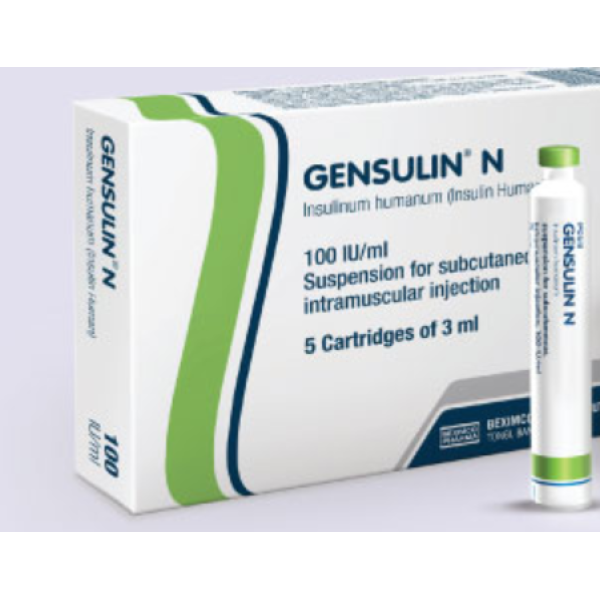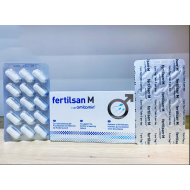
- Stock: In Stock
- Brand: Beximco Pharmaceutical
- Product ID: Human Insulin
100% Secure Payment

This Item is for pre order
WHAT GENSULIN® N IS AND WHAT IT IS USED FOR?
GENSULIN® N contains human insulin produced by DNA recombination using bacteria Escherichia coli. The insulin is identical to insulin produced by human organism. Insulin is a hormone secreted in the human pancreas. It is involved in carbohydrate, fat and protein metabolism and causes, among others, blood glucose reduction. Insulin deficiency leads to diabetes. Insulin administered in injections acts identically to the hormone produced by the human body.
GENSULIN® N is presented in 10 ml vials used with a special syringe or in 3 ml cartridges used with an insulin administration device.
GENSULIN® N (isophane suspension) is a long-acting insulin. The onset (blood sugar reduction) occurs within 1.5 h from injection, the peak action-between 3 and 10 h (depending on the dose) and the duration is 24 h.
BEFORE YOU USE GENSULIN® N
When you must not use GENSULIN® N
GENSULIN® N must not be used when symptoms indicative of hypoglycaemia (low blood glucose) occur.
GENSULIN® N must not be used in patients with hypersensitivity to insulin or any excipient used in GENSULIN® N.
GENSULIN® N should be given cautiously in the following cases:
- History of allergic reactions to any insulin preparation, medicinal product, food, preservative or colorant.
- When alcohol is consumed: symptoms indicative of hypoglycaemia should be taken account of, alcohol should never be taken on empty stomach.
- When the patient does more exercise that usual or changes the diet.
- Disease with high fever, severe infection, strong emotions, alimentary tract disease or disorder with vomiting, diarrhoea, delayed gastric empting and absorption disorder. In such cases blood and urine glucose should be controlled often and all irregularities should be consulted with a doctor. If possible, the recommended insulin doses and regular meals should be taken.
- When a foreign trip is planned, a change of the time zone may result in changed insulin requirement and modification of injection timing may be required. Prior to a trip during which at least two time zones will be crossed, the doctor should be consulted with respect to the modification of the insulin administration mode. During an air trip, insulin should be kept in the hand luggage and not in a luggage hatch (it must not be frozen).
Consult your doctor even if the above-mentioned warnings refer to occurrences in the past.
Using GENSULIN® N with food and drink
Regular and substantial meals should be consumed.
Precautions in special patient groups:
Patients with:
- Pancreatic diabetes
- Pituitary, adrenal and thyroid dysfunction
should consult the doctor since it may be necessary to modify the insulin dose.
Using GENSULIN® N in patients with impaired renal function
Insulin requirement can be significantly changed in renal and hepatic dysfunction.
Using GENSULIN® N in senior patients
In senior patients the duration of insulin action is longer.
Pregnancy and breastfeeding
Consult your doctor before applying the drug.
Pregnancy in a diabetic patient is an indication for insulin therapy. During pregnancy it is very important to maintain the right blood glucose since excessive levels of blood glucose can have teratogenic effects on the foetus. During the first trimester, insulin requirement decreases, thus the insulin dose should be reduced. Insulin requirement increases gradually during the second and third trimester, on average by 75% of the pre-pregnancy dose.
Immediately after delivery insulin requirement becomes abruptly reduced.
During pregnancy, pregnancy planning and breastfeeding: consult your doctor.
In diabetic breastfeeding mothers it may be necessary to modify the insulin dose and/or diet since during lactation insulin requirement is below the pre-pregnancy level and comes back to the initial level after 6-9 months.
Driving and operating machines
The ability to drive may be impaired as hypoglycaemia slows reaction time and dulls concentration. Initiation of insulin therapy, drug change, stress and excessive exercise – associated with significant changes in blood glucose – can result in impaired ability to drive and operate machines. The patient should refrain from driving when symptoms indicative of hypoglycaemia occur. The doctor should be consulted to determine patient’s ability to drive and operate machines in case of frequent hypoglycaemia or difficulty in recognising its symptoms.
It is recommended to control blood glucose levels during long trips.
Using GENSULIN® N with other drugs
Inform your doctor if you are taking or have recently taken any other drugs, even those sold without prescription (cold, catarrh, cough and fever remedies, appetite-suppressing drugs) since they can affect your insulin requirement.
GENSULIN® N should not be mixed with insulin of animal origin and biosynthetic insulin of other manufacturers.
Many frequently used medications (some hypertension drugs, cardiac medications, lipid-lowering drugs, thyroid medications, some antidepressants, anticonvulsants, salicilates, antibacterial agents and oral contraceptives) may affect insulin action and the efficacy of insulin therapy. Thus the doctor should always be informed about all medications administered regularly or periodically. Consult the doctor or pharmacist prior to using a non-prescription medication too. The doctor should always be consulted before a therapy with a new drug is started. When a doctor is consulted with reasons other than diabetes, they must be informed about insulin therapy.
Drugs and substances increasing insulin action: oral hypoglycaemic (antidiabetic) agents, salicilates (e.g. acetylsalicylic acid), some antidepressants (monoamine oxidase inhibitors MAOI), some angiotensin-converting enzyme inhibitors (ACEI) (captopril, enalapril), non-selective ß–adrenolytic drugs (propranolol, sotalol) and ethyl alcohol.
Drugs and substances reducing insulin action: glucocorticosteroids, thyroid hormones, growth hormone, danazol, ß2-sympathomimetics (ritodrine, salbutamol, terbutaline), diuretic thiazides (e.g. hydrochlorothiazide) and niacin.
Insulin requirement may be changed by somatostatin analogues (octreotide, lanreotide).
Pioglitazone (oral antidiabetic drug):
For some patients with long-term type 2 diabetes treatment and a cardiac disease or a history of stroke, cases of cardiac insufficiency have been reported with concomitant administration of pioglitazone and insulin. Consult a physician immediately if you develop any cardiac insufficiency symptoms, such as shortness of breath, sudden body weight increase or local oedema.
HOW TO USE GENSULIN® N
Follow your doctor’s recommendations closely. In case of doubt, contact your doctor.
In clinical practice there are many insulin therapy models. The right regimen, satisfying the individual patient needs, should be selected by the doctor. On the basis of blood glucose, the doctor defines the right dose and type of insulin product for the patient.
Dose modification, decision to mix insulin products and change into other insulin preparations can be made by the doctor only.
The patient should check blood and urine glucose levels with simple tests (e.g. strip test). When the glucose levels are not correct, inform your doctor. The doctor should be consulted regularly, especially during the first weeks of insulin therapy.
Before you use GENSULIN® N
- check the label on the outer packaging and on the vial or cartridge for product name and letter-symbol compliance with the insulin recommended by your doctor,
- check the expiry date marked on the packaging.
Administration mode
GENSULIN® N product is administered subcutaneously. In exceptional cases GENSULIN® N can be administered intramuscularly.
Use the insulin dose recommended by the doctor or nurse in the diabetes clinic.
Change the injection site to avoid skin thickening (see point 4: Possible adverse effects). It is best to inject insulin in the abdominal area, buttocks, anterior thigh or arm. Abdominal insulin injection results in faster absorption than injections in other areas.
Change injection sites, do not inject insulin into the same area more frequently than once a month.
Take insulin out of the refrigerator a dozen or so minutes before the injection to make it adjust to ambient temperature (if you start a new vial or cartridge). Used vial or cartridge can be kept at room temperature for a month.
Observe hygiene rules during administration: wash your hands before drug administration and disinfect the injection site.
Before drug administration, examine the insulin vial or cartridge closely
The suspension GENSULIN® N should be uniformly non-transparent (uniformly turbid or milky). Do not use the product if after mixing the content of the vial or cartridge remain transparent or a while deposit stays on the bottom. Do not use it either if after mixing white flicks are visible or white stable particles stick to walls making the container look frosty.
While making an injection, use caution not to introduce the needle into vascular lumen.
Administering GENSULIN® N in vials using a syringe
Insulin should be administered with special syringes marked with insulin units. It is recommended to use syringes of the same type and manufacturer. Always check whether the syringe you are using is scaled for the strength of insulin used.
Prior to administering GENSULIN® N suspension, roll the vial in your hands 10 times and then turn it 10 times by 180° to obtain uniformly turbid or milky suspension. If the effect is not obtained, repeat the procedure till the ingredients are mixed. Do not shake as foam formed in the container can make it difficult to properly measure the insulin dose.
The procedure
Immediately before injection:
- Tear off the protective ring incised in the central part of the cap.
- Wipe the exposed part of the stopper with alcohol. Do not take the stopper out!
- Draw into the syringe a volume of air equal to the insulin dose.
- Pierce the rubber stopper with a needle placed on the syringe and inject the air into the syringe.
- Invert the vial with the syringe.
- Make sure the needle tip is immersed in insulin solution or suspension.
- Draw into the syringe the appropriate volume of insulin.
- Remove air bubbles from the syringe.
- Check the recommended dose again and withdraw the needle from the vial.
- Disinfect the skin at the injection site.
Injecting insulin:
- Stabilise the skin with one hand by lifting or pinching big surface to form a skin fold.
- Take the syringe with the other hand and keep it like a pencil. Pierce the needle into the skin (at 90° angle). Make sure the needle is fully inserted and well placed in subcutaneous fat and not in deeper skin layers (in very slim patients it may be necessary to place the needle not perpendicularly but at an angle).
- To inject insulin push the plunger to the very end in less than 5 seconds.
- Keep a cotton pad with alcohol close to the needle and remove the needle from the skin. For a couple of seconds press the cotton pad with alcohol to the injection site. Do not rub the skin.
To prevent tissue damage, change the injection site every time you administer the drug. The new injection site should be at least 1-2 cm from the old one.
Administering GENSULIN® N in pen cartridges
3 ml cartridges are administered with a pen bearing the CE mark in accordance with the manufacture’s instruction.
To load the pen, place the needle and inject insulin, closely follow the instruction of the pen manufacturer attached to the pen.
GENSULIN® N suspension should be mixed prior to each injection by turning the cartridge upside down at least 10 times or rolling it in your hands until the content become uniformly turbid or milky. The content of the cartridge can be mixed without taking it out of the pen.
Cartridge construction makes it impossible to add different insulin to the cartridge.
Used cartridges cannot be refilled.
If necessary, insulin can be drawn out of the cartridge with a regular insulin syringe and the above-mentioned procedure should be applied (depending on insulin concentration and type of insulin preparation).
Mixing GENSULIN® R solution with GENSULIN® N suspension
The decision on mixing GENSULIN® R with suspension can be made only by a doctor. While making the mixture, always introduce short-acting GENSULIN® R first into the syringe. Apply the above procedure to administer the drug.
If you take more GENSULIN® N than you should
If you take more GENSULIN® N than you should, immediately consult a doctor or pharmacist. Insulin overdose evokes hypoglycaemia (blood sugar is too low). The symptoms include: apathy, confusion, palpitation, headache, sweating and vomiting.
In moderate hypoglycaemia it will suffice to administer sweet drinks or carbohydrate-rich food. The patient should take a rest. Patients should carry sugar cubes, glucose or sweets on them.
Severe hypoglycaemia can lead to convulsions, loss of consciousness and even death. The patient can regain consciousness after glucagon injection made by a trained person. After a glucagon injection, immediately upon consciousness regaining, the patient should eat sugar or a sweet snack. If the patient does not regain consciousness after a glucagon injection, hospitalisation is required. Each time glucagon is administered, the patient should seek medical advice to determine the cause of hypoglycemia and methods to prevent it in future.
Patient’s relatives, friends and colleagues should be informed that in case of consciousness loss, they should place the patient on their side and immediately seek medical advice. The patient in such condition must not be given any drinks or food due to the risk of chocking.
In case of hypoglycaemia with consciousness loss or frequent hypoglycaemic conditions, the doctor should be consulted as it may be necessary to change the insulin dose and administration timing as well as diet and physical activity.
Hypoglycaemia causes:
- injection of a too high insulin dose
- too small or skipped meal
- more physical exercise that usual
If you forget to take GENSULIN® N
In case you forget to take GENSULIN® N, blood glucose levels can be too high (hyperglycaemia), Hyperglycaemia symptoms occur gradually. The symptoms include: sleepiness, face reddening, excessive thirst, appetite loss, acetone breath, accelerated breathing and pulse.
In case any of the above-mentioned symptoms occur, measure blood glucose and, if possible, examine ketone bodies in the urine and immediately contact the lead doctor.
These can be symptoms of a very serious condition – ketoacidosis. Untreated ketoacidosis may lead to insulin coma and even death.
Other reasons of hyperglycaemia, apart from skipping an insulin dose, are: infection or fever, excessive meal and reduced physical exercise.
POSSIBLE ADVERSE EFFECTS
Like all drugs, GENSULIN® N can cause adverse effects, although not everybody gets them. GENSULIN® N can cause hypoglycaemia (low blood sugar). See point 3: How to use GENSULIN® N. Frequent adverse effects: (1/100 to 1/10)
- topical allergic reaction – at insulin injection site erythema, oedema and itching may occur. The symptoms usually disappear after a couple of days or weeks. In some cases, topical reactions can be caused by factors other than insulin, e.g. irritating substances included in skin disinfectants or a wrong injection technique.
Infrequent adverse effects:
(1/1000 to 1/100)
- Lipodystrophy (thickening) at injection site.
Very rare adverse effects:
(<1/10000)
- systemic allergic reactions indicative of generalised hypersensitivity to insulin. The symptoms include: eruption all over body, dyspnoea, wheezing breath, lowered arterial pressure, accelerated pulse and sweating. In serious cases, generalised allergy symptoms can be life threatening. Rare cases of severe allergy to GENSULIN® N require immediate treatment. Insulin change or desensitisation can be necessary.
Inform your doctor or pharmacist if an adverse effect intensifies or if you experience an adverse reaction not covered by this leaflet.
STORING GENSULIN® N
Store in a refrigerator (2°C-8°C)
Do not freeze.
Keep in the original packaging to protect from light.
Upon opening the packaging, the product is 28 days stable at temp. up to 25°C. Vials and cartridges that are used or intended to be used should not be kept in a refrigerator. The patient can carry them on themselves.
GENSULIN® N should be protected from high temperature.
Keep out of the reach and sight of children.
Do not use GENSULIN® N after the expiry date marked on the label.
The drug must not be disposed to the sewage system or home waste containers.
Ask the pharmacist about disposal of the unneeded medication. By doing so you can help protect the environment.
OTHER INFORMATION
What GENSULIN® N contains:
- The active substance is recombinant human insulin obtained by means of biotechnological recombination. 1 ml contains 100 IU of human insulin. The vial contains 10 ml corresponding to 1000 IU of human insulin. The cartridge contains 3 ml corresponding to 300 IU of human insulin.
- Excipients: m-cresol, glycerol, phenol, protamine sulphate, disodium phosphate dodecahydrate, zinc oxide, hydrochloric acid (for pH modification), water for injections.
What GENSULIN® N looks like and contents of the package
One vial containing 10 ml of GENSULIN® N.
5 glass cartridges for pens containing 3 ml of GENSULIN® N.












%20Pvt.%20Ltd./Movicol-Oral-Powder-190x190.jpg)

